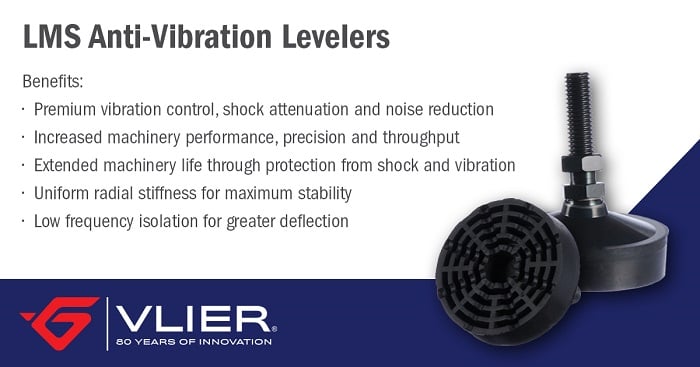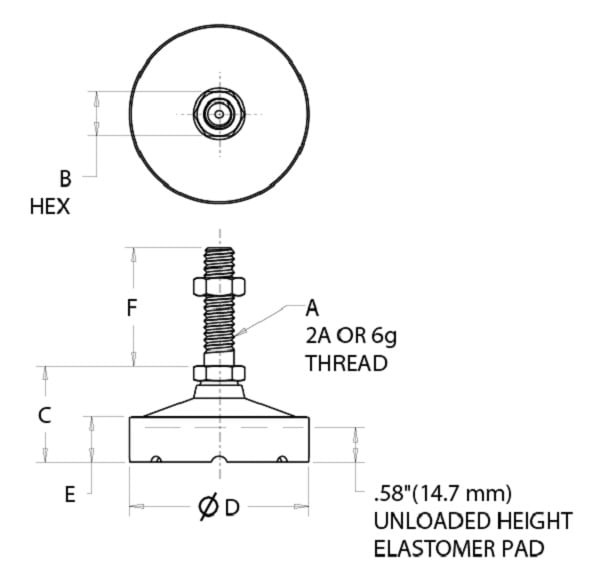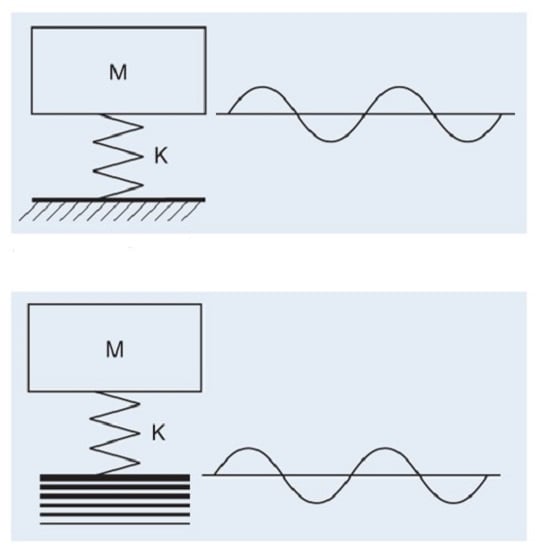In the realm of design engineering, where precision is paramount and equipment performance is critical, the impact of vibration cannot be underestimated. Increasing performance, precision and through-put might be as simple as mitigating shock and vibration out of processes.
 Figure 1: LMS anti-vibration levelers. Source: Vlier
Figure 1: LMS anti-vibration levelers. Source: Vlier
For more than eight decades, engineers and organizations across diverse industries have counted on Vlier’s innovative solutions — particularly its Level Mount Swivel (LMS) anti-vibration leveler — to safeguard high-precision equipment against the detrimental effects of vibration and shock.
Understanding vibration
All operating environments will produce a certain level of shock and vibration loading across normal use, so understanding the basics of this phenomenon is the first step in taking control of these harmful inputs to processes.
The common definition of vibration (from Latin vibro “to shake”) is a mechanical phenomenon whereby oscillations occur about an equilibrium point. Vibration is set in motion by the simple running of a mechanical system, sometimes identified as “natural” or “free” vibration by engineering experts. The running of these mechanical systems produces what is commonly referred to as the natural frequency, which is a critical measurement to identify a proper isolator. Getting that part wrong can have a negative effect that will increase, rather than dampen, vibration.
Another critical element to consider is whether the load is static or dynamic. Think of an industrial washing machine in which loads can shift and become unbalanced, representing a dynamic situation.
 Figure 2: Shock and vibration dampening dissipates the friction that reduces the frequency closer to the equilibrium position. Source: Vlier
Figure 2: Shock and vibration dampening dissipates the friction that reduces the frequency closer to the equilibrium position. Source: Vlier
Shock and vibration dampening dissipates the friction that reduces the frequency closer to the equilibrium position.
Shock, on the other hand, is sometimes defined as the sudden acceleration of an impulse applied to a system. These are generally short-lived events, but they can have significant negative impacts on precision and throughput.
Not arresting shock and vibration results in:
- Mechanical wear
- Metal fatigue
- Connector and electronic damage
- Hydraulic leaks and failures
- Excess noise
- Damage to floors and concrete
Unveiling the LMS advantage
Vlier’s LMS anti-vibration leveler stands out as a pinnacle of precision engineering and performance optimization. Designed as a frequency-tuned, swivel-style leveling device, the LMS offers unparalleled control over vibrations, shock attenuation and noise reduction. These capabilities not only enhance machinery performance, but also extend equipment lifespan, ensuring sustained reliability and efficiency.
Superior vibration control
Vibration-control techniques in the form of shock and vibration isolators have been devised to provide dynamic protection to all types of equipment. In discussing vibration protection, it’s useful to identify the three basic elements of dynamic systems:
1. The equipment (component, machine motor, instrument, part)
2. The support structure (floor, baseplate, concrete foundation)
3. The resilient member, referred to as an isolator or mount (rubber pad, air column, spring), which is interposed between the equipment and the support structure
If the equipment is the source of the vibration or shock, the purpose of the isolator is to reduce the force transmitted from the equipment to the support structure. The direction of force transmission is from the equipment to the support structure. This is illustrated in Figure 3, where M represents the mass of a motor, which is the vibrating source, and K, which is located between the motor and the support structure, represents the isolator.
 Figure 3: Schematic diagram of a dynamic system where the mass, M, is the vibratory source. Figure 4: Schematic diagram of a dynamic system where floor is the vibratory source. Source: Vlier
Figure 3: Schematic diagram of a dynamic system where the mass, M, is the vibratory source. Figure 4: Schematic diagram of a dynamic system where floor is the vibratory source. Source: Vlier
If the support structure is the source of the vibration or shock, the purpose of the isolator is to reduce the dynamic disturbance transmitted from the support structure to the equipment. The direction of motion transmission is from the support structure to the equipment. This occurs, for instance, in protecting delicate measuring instruments from vibrating floors. This condition is illustrated in Figure 4, where M represents the mass of a delicate measuring instrument, which is protected from the vibrating floor by an isolator signified as K.
In either case, the principle of isolation is the same. The isolator, being a resilient element, stores the incoming energy at a time interval that affords a reduction of the disturbance to the equipment or support structure.
The LMS boasts a natural frequency range of 10 Hz to 21 Hz, fused with an impressive transmissibility at resonance ratio of 8:1 and uniform radial stiffness for maximum stability. This unique combination delivers exceptional low-frequency isolation for greater deflection, effectively dampening vibrations that could compromise equipment accuracy and stability, while increasing machinery performance, precision and throughput.
The science behind superior performance
Engineered to safeguard a wide array of high-precision equipment, the LMS has become a trusted choice for industries relying on delicate machinery. Its applications span across:
- Data storage equipment
- Large medical devices
- Industrial workstations
- Electronic manufacturing machinery
- Industrial automation systems
- Semiconductor equipment
At the heart of the LMS’s effectiveness lies meticulous engineering and material selection. Crafted from corrosion-resistant steel, its molded rubber-to-metal base establishes a robust and enduring bond, ensuring long-term durability under demanding operational conditions, including operating temperature ranges from -20° F to 180° F (-30° C to 82° C).
Furthermore, the LMS features a 3 inch radial ring pad, delivering compact yet superior stability essential for precision equipment support.
Recognizing the diverse requirements of design engineers, Vlier offers customizable LMS solutions tailored to individual applications. Whether adapting to unique equipment configurations or addressing specific environmental challenges, the LMS can be modified to meet precise engineering demands, ensuring optimal performance across diverse operational scenarios.
Elevating engineering excellence
As design engineers seek to maximize precision and reliability in high-tech environments, the role of advanced vibration control solutions like Vlier’s LMS cannot be overstated. With its proven track record of enhancing machinery performance, minimizing downtime and extending equipment lifespan, the LMS stands as a testament to innovation in engineering excellence, empowering engineers to achieve new heights of productivity and reliability in their endeavors.
Visit the Vlier website to learn more or request a quote.
